10 Best Cheap Full Frame Camera Reviews for 2024 [Expert Guide]
Gone are the days when owning a full-frame camera was reserved for the elite or those with deep pockets. Today, the landscape has shifted dramatically, with prices plummeting and options expanding, making full-frame photography more accessible than ever before.
When we talk about full-frame, we’re referring to a sensor size equivalent to traditional 35mm film. This puts it among the largest sensors available to photographers, second only to the more exclusive medium and large format sensors, which remain beyond the reach of most.
Many cameras on the market utilize smaller APS-C sensors, while compacts and smartphones opt for even smaller sensor sizes, typically one inch or less.
The advantages of a larger sensor are manifold. With increased light-gathering capability, full-frame cameras excel in low-light conditions. They also offer greater control over depth of field, along with enhanced dynamic range and color reproduction.
In the past, full-frame sensors were confined to bulky, unwieldy cameras that were far from portable. However, the advent of mirrorless technology has revolutionized the landscape, giving rise to compact yet powerful cameras that house a full-frame sensor. This means you can now enjoy the benefits of a large sensor without sacrificing portability.
As prices continue to drop and technology advances, there has never been a better time to explore the world of full-frame photography. Whether you’re an enthusiast looking to upgrade or a novice seeking an entry point into professional-quality imagery, the options are plentiful, and the opportunities are endless.
Capture More with Less: The Best Cheap Full Frame Cameras
Things being what they are, do you need to change to a full-frame camera? Fantastic! Nowadays, even the best cheap full-frame camera offers you excellent pictures. Here’s a rundown of the ten best cheap full-frame cameras in 2024.
1. Canon EOS 6D Mark II Digital SLR Camera Body – Wi-Fi Enabled
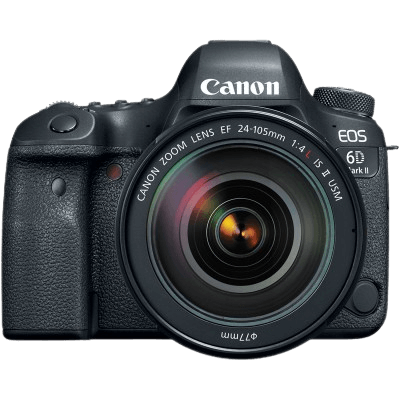
The EOS 6D II is Canon’s least expensive full-frame DSLR, and the subsequent stage is up from the EOS 90D. It may be reasonable. However, it’s a long way from fundamental. The upside of a full-frame sensor is that it gives unrivaled picture quality because you will, in general, get more megapixels, and mainly because the pixels (photosites) are more significant and can catch all the more light.
The 26-megapixel sensor in the 6D II offers a valuable favorable position compared to 24-megapixel cameras. It has a groundbreaking 45-point AF system for viewfinder shooting and Canon’s Dual Pixel CMOS AF for live view photography, and it has a conventional 6.5fps continuous shooting speed. What we truly love is the smoothed-out dealing with and control format and the thoroughly articulating back screen.
The 6D Mark II’s standard self-adjust system gets an update as well, with a 45-point array (all cross-type) that is lighted a long time in front of the old model’s antiquated nine-point framework, and Canon’s most recent DIGIC 7 picture processor helps object acknowledgment and center following to anticipate subject movement over the frame.
The new sensor and DIGIC 7 blend deliver an ISO scope of 100-40,000, expandable to 50-104,400. The first EOS 6D was a decent low-light entertainer. However, the new model offers both higher ISOs and higher resolutions.
Pros
- Fully articulated touchscreen
- Novice-friendly but powerful too
Cons
- Full HD video not 4K
- Bulkier than the EOS RP
2. Sony a7 Full-Frame Mirrorless Digital Camera with 28-70mm Lens
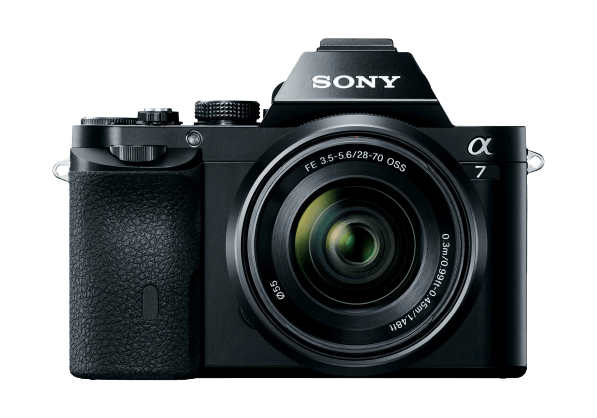
This is likely the cheapest full-frame camera we’d suggest getting, mainly if the majority of a ‘full-size’ full-outline DSLR puts you off. The little and lightweight Sony A7 is the first full-casing mirrorless camera, and it is currently an outright deal.
It falls short on some serious highlights, such as adjustment, touchscreen usefulness, and 4K video; however, the nature of the Raw pictures created by the 24.3MP Exmor CMOS sensor keeps on intriguing after these years.
The Sony Alpha 7 is a full-frame E-mount mirrorless camera. The A7 is fundamentally the same as its increasingly costly kin (the A7R), but it utilizes a 24-megapixel CMOS sensor with an on-chip stage location. The A7 twins are the smallest and lightest full-frame cameras available.
While the cameras can utilize any E-mount lens, a yield factor will be included (except if you don’t fret about igniting). Sony is delivering another line of FE-series lenses that exploit the bigger sensor.
The A7s utilize the new Sony Bionz X processor, which produces pictures with better detail, less noise, and diminished diffraction. Other highlights incorporate a 3-inch, inclining LCD, XGA OLED electronic viewfinder, Multi-interface (hot) shoe, Wi-Fi with NFC, and 1080/60p video recording.
The Alpha 7 has kicked off something new in the full-frame market as far as size and cost are concerned. While it’s not great, the A7’s minimal size, expansive list of capabilities, and excellent crude picture quality ostensibly compensate for issues like generally poor battery life and somewhat overprocessed JPEGs.
Significantly, the battery life of the first Sony A7 was impoverished. However, the camera’s moderately low price implies that you can get an extra battery or two, too.
Pros
- Compact
- Impressive image quality
- Amazing price
Cons
- Poor battery life
- No stabilization
- No 4K video
3. Sony a7R II Full-Frame Mirrorless Interchangeable Lens Camera, Body Only
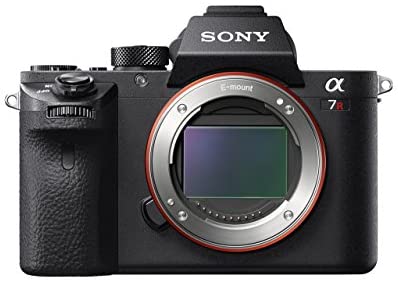
Conceivably the most talked about best cheap full-frame camera expounded on and contended over the highest megapixel camera in ongoing memory, the Sony A7R II is creating a significant stir.
Sony has been exceeding itself with each new variation of the A7 arrangement, yet with the A7R II, it’s gone past essential transformative redesigns.
The mirrorless tradable lens camera is stuffed with bleeding edge parts, just as a stunt or two at its disposal (clue: Canon clients, observe). Indeed, it’s anything but complicated to get hypnotized by extravagant specs. However, the A7R II conveys quality, as well.
A7R II has the extraordinary capacity to utilize Canon lenses in addition to autofocusing them (stage identification). To do this, you’ll require a connector from Fotodiox or Metabones. Contingent upon the lens, it will focus automatically utilizing the A7R II’s autofocus system – one fundamental explanation of why this camera has made so much buzz. As we brought up in our correlation test, a few lenses won’t work. Be that as it may, it opens up the door for Canon lens proprietors to utilize a Sony mirrorless camera without purchasing new glass.
Additionally, on the front is an AF Help light to help center in low light, a remote sensor on the finished hold, and a lens release button. With the A7R II high-megapixel camera, you get eminent photographs, 4K recordings, worked-in five-pivot adjustment, an extraordinary AF system, and the capacity to utilize some Canon lenses, just to give some examples. This camera is certainly worth the promotion on the off chance that you can manage the cost of it; get it.
Try not to kick me off on the battery life. Fundamentally, when you’re not shooting, you’re charging. You need at least two batteries for a day of work with this camera, particularly in case you’re a substantial viewfinder client. Likewise, with drone battery life, which is similarly terrible, we’ve become accustomed to the restricted battery life of most mirrorless tradable lens models.
Pros
- 42.4MP BI full-frame sensor – industry first
- 4K movies
- ISO up to 102,400
- Can autofocus some Canon lenses (via adapter)
- Five-axis image stabilization
Cons
- LCD non-touch capable
- Movie button still not easily accessible
- EVF has slight lag
4. Sony a7 III ILCE7M3/B Full-Frame Mirrorless Interchangeable-Lens Camera with 3-Inch LCD

- 24MP full-frame sensor
- Fast and accurate autofocus
- Up to 10fps continuous shooting
- 4K video recording
- Image stabilization
A perfect starter pack, the Sony Alpha a7 III Mirrorless Digital Camera with 28-70mm Lens and Accessories Kit from B&H broadens the camera’s adaptability with the expansion of a camera sack, a memory card, a battery charger, and a 55mm UV filter.
Past updates to the imaging framework, the a7 III’s body configuration has additionally been overhauled to incorporate a back 3.0″ 922k-dot touchscreen LCD, which has a tilting configuration to help work from high and low angles.
A 2.36m-dot Tru-Finder OLED EVF is additionally highlighted for brilliant and clear eye-level checking. Double SD and memory card spaces are presently included for more prominent shooting adaptability, and a bigger NP-FZ100 battery is likewise utilized to accomplish up to roughly 710 shots for each charge.
Fitting the camera’s utilization in attempting conditions, the magnesium-combination suspension and climate fixing likewise render the a7 III residue and dampness safe.
While Nikon and Canon are caught up in wasting time (or possibly giving that impression) regarding genuine mirrorless cameras, Sony is surprising the market. The eminent A9 is the camera to beat; however, on the off chance that you don’t have an extra 5k lying around, it’s not actually open to most.
Step in the A7 III, an excellent all-rounder accessible at a considerably more moderate £2,000. For that money, you get a terrible part of highlights, including 10fps shooting, a 24.2-megapixel back-lit-up sensor, fabulous 4K video creation, and a body that is small and minimized.
The general system is still huge – focal points, despite everything, should be entirely massive to be coordinated with a full-outline sensor – however, something else, this is nearly the ideal camera for fans no
Pros
- Fantastic AF system
- 10fps burst shooting
- 4K video
- Compact body
Cons
- Limited touchscreen functionality
- Overall system still large
5. Sony Alpha a7II Mirrorless Digital Camera
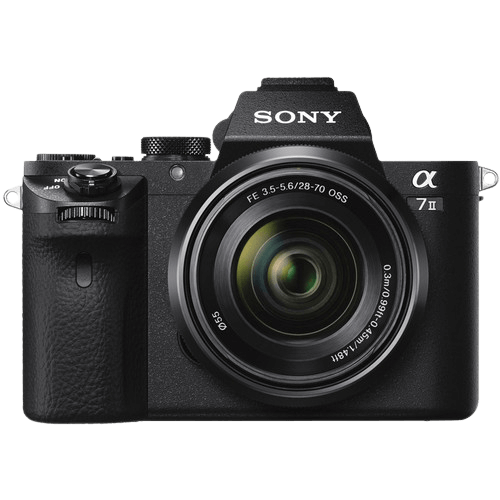
Sony has additionally given the Alpha A7 II a portion of the video highlights of the A7S. For instance, it would now be able to record in the XAVC S, AVCHD, or MP4 position.
In addition, there’s synchronous double arrangement recording in MP4 and XAVC S or MP4 and AVCHD organization to give a simple configuration for sharing alongside information-rich film for altering.
Likewise, picture profiles offer the capacity to set the Gamma to Sony’s S-Log2 for diminished difference and a more noteworthy unique range. In addition, the Time Code highlight assists with scene distinguishing proof and film adjusting from numerous cameras. You can likewise join an XLR receiver by means of a connector.
On the still pictures side, the Sony Alpha A7 II supports uncompressed 14-bit crude picture capture. This element came later into the camera’s life by method of the firmware 2.0 update that was released on November 18. Prior to it, the Sony Alpha A7S II and A7R II both bolstered uncompressed crude shooting.
The most excellent news about the Alpha A7 II is that it’s Sony’s first full-frame conservative framework camera to highlight in-body adjustment. This implies the sensor can move to address unintentional camera developments during the introduction.
This 5-hub in-camera picture adjustment might not entice existing A7 clients to update, but it does make the new camera more alluring to new purchasers than the more established model.
This is one of the best full-frame mirrorless cameras, but the camera doesn’t come with a best position record button. Moreover, it is pretty expensive compared to its older model.
Pros
- Size and handling
- Image quality
- Effective in-body stabilization system
Cons
- Viewfinder colors slightly under saturated
- Position of Record button
- Significant price increase over A7
6. Sony ILCE7S/B Alpha a7S Mirrorless Digital Camera
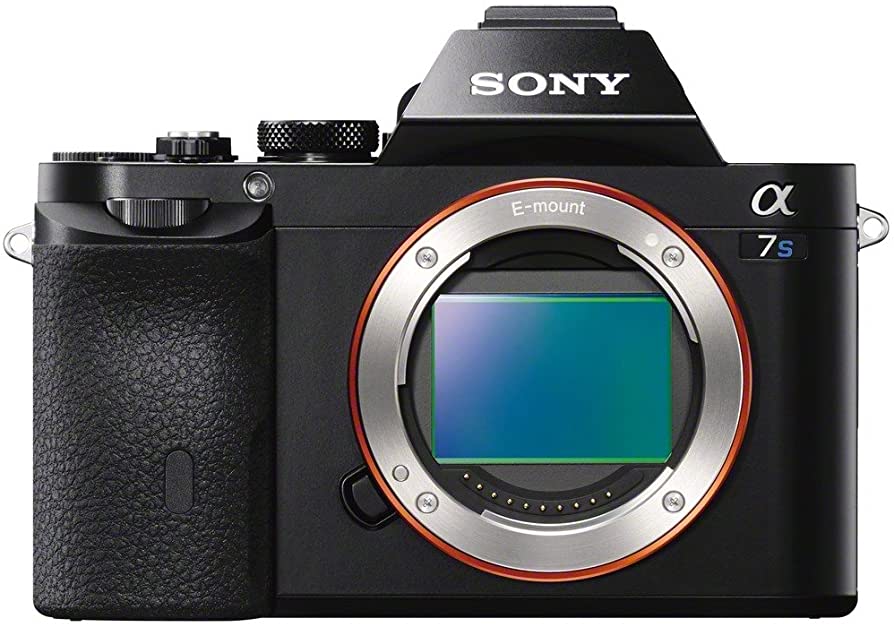
The Sony Alpha a7S Mirrorless Digital Camera includes a full-frame 12.2MP Exmor CMOS sensor and BIONZ X picture processor to empower prominent video and still picture quality with a sweeping unique range, low clamor, and stretched-out affectability to ISO 409600.
At the sensor level, this full-outline sensor includes a one-of-a-kind on-chip gapless focal point structure, which consolidates little focal lenses between neighboring pixels so as to expand light-social occasion proficiency and advance more noteworthy picture quality over the sum of the sensor plane.
The sensor and processor blend additionally benefits an abundance of speed all through the camera framework, including a top nonstop shooting rate of 5 fps, support for 4K video recording, and a quick 25-point balance discovery AF framework with affectability to – 4 EV.
Past its excellent picture execution, the a7S is also very adept at recording video. It can yield uncompressed 4:2:2 UHD 4K video to a discretionary outer recorder over HDMI and record full HD 1080p video in the excellent XAVC S position at 50 Mbps in numerous frame rates.
Support for S-Log2 gamma broadens the video recording abilities, assisting with extending the successful, powerful range during recording, just as picture profile choices, time code, and zebra marker show help. Sound can be recorded in the AAC/Linear PCM position by means of the inside sound system mouthpiece, with an implicit earphone jack for onboard observation, or through an outer microphone.
You may be enticed to ignore this best cheap full-frame camera due to its low megapixels. I think you certainly need to give it a possibility because megapixels aren’t the most significant thing.
This camera is more than magnificent in low-light circumstances. You can shoot at ISO 80,000 without stressing over demolishing the picture. Likewise, in ordinary circumstances, the picture quality is astounding. If you’re not searching for crazy subtleties and trimming power, the A7S may be the camera for you. It’s certainly not the best budget full-frame camera in this rundown, however.
Pros
- Extraordinary value
- Very good image quality
- Compact body
Cons
- No 4K video
- No in-body stabilization
- Relatively low-spec screen and EVF
7. Nikon Z6 Mirrorless Digital Camera
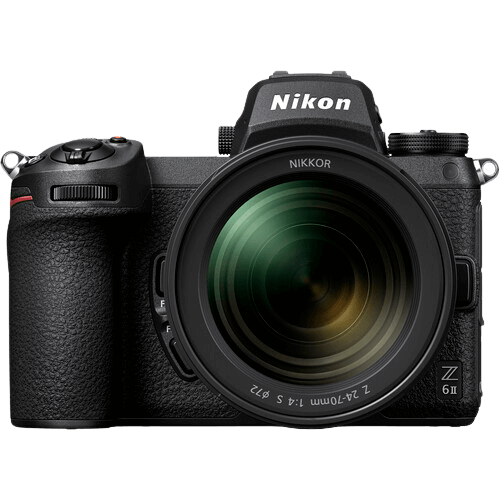
The Nikon Z7 may have a progressively noteworthy spec sheet, but for those searching for an inside-out full-frame mirrorless camera model at a lower value, the Z6 is the best mirrorless camera on the planet at the present time.
It includes a lower-goals sensor than its progressively costly kin, but that implies it performs marginally better in low light and encourages quicker edge paces of up to 12fps. Also, handling and manufacturing quality are actually equivalent to the Z7, as both utilize indistinguishable bodies.
Nikon truly gave the picture taker thought when structuring the Z 6 (and by augmentation of the Z 7). Offering DSLR-like taking care of in a little – yet not very little – body. In the event that you’re someone running over from Nikon DSLRs, at that point, you’ll feel right comfortable getting the Z 6. A decent estimated handgrip causes it to feel extremely great to use for significant periods.
At launch, Nikon brought out three exclusive focal lenses: a 24-70mm f/4 focal lens, a 35mm f/1.8, and a 50mm f/1.8. In the interceding months, two additional optics have gone to the market, including a super-wide-edge 14-30mm f/4 focal point and a 24-70mm f/2.8 focal lens, which is focused on masters.
In spite of the fact that we expect more not long from now, for the time being, it’s a moderately constrained line-up. There is consistently the alternative to swear by utilizing the Nikon F mount focal lens through the discretionary adapter. Controls are spread over the Z 6’s body in a truly reasonable course of action that gives unquestionably more breathing space for the catches than the Sony mirrorless models, which have consistently felt ungainly to utilize.
Some may find the single XQD card slot a drawback; however, when a camera is this acceptable, we can excuse it.
Pros
- Superb high-ISO quality
- Full frame 4K video
- Build quality and handling
Cons
- Average buffer capacity
- Single XQD card slot
- Limited native lens range
8. Nikon D850 FX-format Digital SLR Camera Body
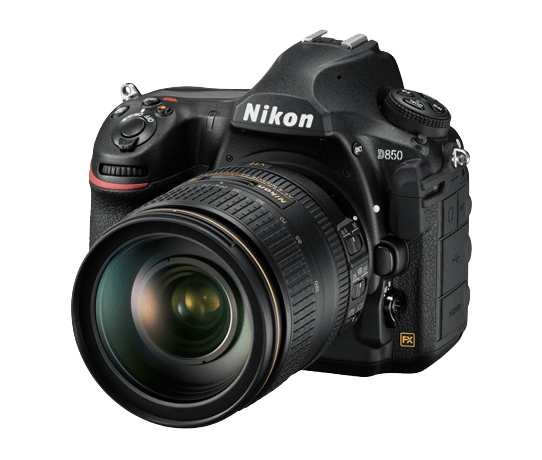
The Nikon D850 FX-format digital SLR camera has a full-frame image sensor with no optical low-pass filter and an extravagant 45.7-megapixel resolution lens. It can shoot and record videos at full resolution and with full AF performance up to 9fps in continuous shooting.
It can record videos in 8 K and 4 K. It features a tilting touchscreen with focus shift shooting mode and an outstanding battery.
It records videos in 4K ultra HD with a slow motion up to 120 fps at 1080p resolution. Presently, after five years, Nikon gladly presents the next evolution in high-resolution DSLRs, a camera that enables picture takers to catch quick activity in 45.7 megapixels of splendid goals. With noteworthy headways in all cases—sensor structure, self-adjust, dynamic range, affectability, Speedlight control, battery life, shade and mirror drive systems, Silent Photography in Live-View mode, center move capacity, and that’s only the tip of the iceberg—this is potentially the most unique, balanced DSLR yet.
At the core of the D850 is a Nikon-designed sensor like none before it—a rear-enlightened (BSI) FX-position full-frame CMOS picture sensor with 45.7 megapixels and no optical low-pass channel. A wonder of inventiveness, it accomplishes remarkable picture quality, improved light assembly productivity, quicker information readout, and more genuine shading.
What’s more, with such a thick display of pixels, there’s, for all intents and purposes, no danger of moiré. Quicker than EXPEED 4, EXPEED 5 rapidly processes all 45.7 megapixels of information for lower noise, more extensive powerful range, unpretentious tonal and textural subtleties, fast persistent shooting at approx. Nine fps1, and full-outline 4K UHD motion picture recording.
Nikon D850 flip-screen DSLR camera enables the user to make a 30-minute maximum movie. However, there is no 4K recording support @ 60fps, no built-in flashlight, and a sluggish built-in Wi-Fi experience. The optical viewfinder only covers 98% of the screen. Such issues might not attract photographers to this Nikon flip-screen DSLR camera.
Pros
- Fast startup
- Spectacular dynamic range
- 45.7 megapixel CMOS sensor
- Low shutter lag
- Fast AF speed
- Excellent high ISO performance
Cons
- No built-in flash
- Slaggy built-in Wi-Fi
- No 4k@60fps
- 30min video clip
- No AF illuminator
9. Nikon D610 24.3 MP CMOS FX-Format Digital SLR Camera
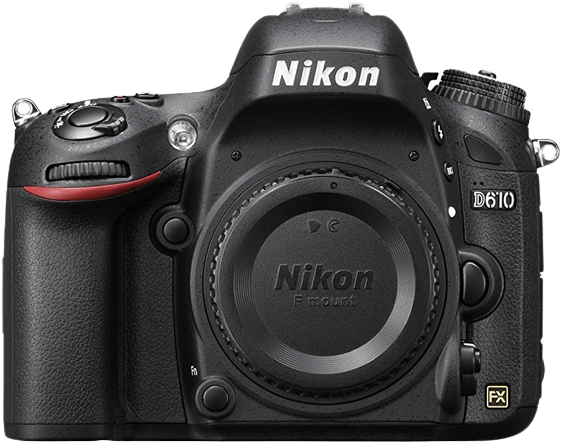
- The Nikon D610 is a camera model made by Nikon. It is a full-frame DSLR camera, which was launched by Nikon on October 8, 2013. It was an improvement of the Nikon D600, with sped up and a manual focus setting with better white balance.
The Nikon D610 is a camera model made by Nikon. It is a full-frame DSLR camera, which Nikon launched on October 8, 2013. It was an improvement of the Nikon D600, with a sped-up and manual focus setting and better white balance.
The new shutter mode unit bolsters a tranquil mode at three edges for each second, with the typical consistent mode at six frames for every second. The past model, the 6300, had issues identified with its shade, so the improved highlights were uplifting news for all picture-takers, movie producers, and video lovers.
Every standard camera has an ISO range of 200 to 1600, which is viewed as the typical range. You can say that the D610 has two ISO ranges, an ordinary one and an all-encompassing one. The typical one ranges from 100 to 6400, which is currently way better than the standard ISO range; however, the all-encompassing one ranges from an astounding 50 to 25,600, which is simply stunning.
With this range, you can take pictures around evening time or in shallow lighting without hardly lifting a finger, even in conditions with low differentiating factors. With this camera, terrible lighting conditions can never again be a reason for an awful photograph.
Photographs and recordings of good quality should be well honed, where you can catch everything about once. That is currently conceivable with the D610’s 24.3-megapixel FX-design CMOS sensor, which is the ideal component for catching great photographs and recordings. Alongside that comes its broad, powerful range, high sign-to-clamor proportion, and a long-run ISO that adds to excellent pictures and recordings, even in low difference, low light, and high commotion conditions.
Is the D810 a lot for you? Have a look at the affordable full-frame DSLR, the Nikon D610. The picture quality is extraordinary, even at high ISO values. The self-adjust is additionally remarkable, and it’s worked to endure forever, much the same as the 810. A couple of disadvantages are the absence of Wi-Fi and the fixed LCD screen.
Pros
- Great image quality
- Precise autofocus system
- Two video formats
- Wi-Fi compatibility
Cons
- Low-quality products
- Dust-like splotches on the lens
10. Canon Full Frame Mirrorless Camera [EOS R]|
The Canon EOS R showed up in 2018, seeing Canon dispatch a fresh out of the plastic new camera framework worked around the RF mount. After two years, the maker has worked superbly to understand its desire for the R framework, with a developed focal point setup that includes probably the best glass in the business. Nonetheless, the restrictions of the EOS R remain.
While the Canon EOS R is outstanding amongst other Canon cameras, its case is that the best full-frame mirrorless camera seat is assembled totally in its place inside the Canon environment instead of any champion abilities of its own. It is adequately a Canon EOS 5D Mark IV without a mirror or a subsequent memory card opening, yet with access to the scope of staggering (if costly) RF lenses.
In any event, when it was launched, the Canon EOS R looked moderate as opposed to historic. It’s an incredible confirmation of the idea, with extraordinary highlights, for example, the new Control ring and M-Fn Bar, and consistent similarity with existing EF focal points. While it thinks about well to a DSLR, however, its edited 4K video and absence of in-self-perception adjustment place it behind its Sony, Nikon, and Panasonic rivals – and now it faces rivalry from the less expensive EOS RP, as well.
Its 30.3MP sensor doesn’t offer the goals of stills cameras like the Sony A7R IV, Nikon Z 7, or Panasonic S1R, and its edited 4K video is an irritated point close to the best 4K cameras. However, that leaves a gap in the arrangement for the remarkable Canon EOS R5… and we likewise expect the Canon EOS R6 to join the line-up soon as well.
Pros
- Great control customization
- 5,655(!) focus positions
- Fully articulating screen
Cons
- No in-body stabilization
- Cropped 4K video
- Single SD card slot

